In this Article
Adopting a wide golf stance wider than shoulder width provides stability, power and consistency. Learn exactly how to widen your footing, flare feet outward, maintain spine angle and fully rotate hips. Tips to optimize stance width for driver, irons, wedges and putter based on desired ball flight. Master this technique through focused practice to improve driving distance, accuracy, finesse and injury prevention.
A wide golf stance is a key fundamental that can significantly enhance your overall golf game. This refers to positioning your feet wider than shoulder-width apart when setting up for a shot. Adopting a wide stance provides many advantages that can lead to improvements in power, accuracy, consistency, and injury prevention.
In this comprehensive guide, we will explore what exactly constitutes a wide golf stance, why it is beneficial, how to execute it properly, mistakes to avoid, and tips for practicing it effectively. We will also examine how stance width may need to be adjusted based on the club you are using, from driver to wedge.
Implementing a purposefully wide stance may feel unnatural at first. But with practice, it can become a valuable weapon in your golfing arsenal. A wide stance activates muscles in the hips, core, and legs to generate more force. It also keeps you balanced and centered throughout the swing plane. Mastering this fundamental will provide a solid foundation upon which to build your optimal golf swing.
Whether you are just learning the game or a seasoned player looking to enhance your skills, a wide stance is a technique worth exploring. By standing with your feet wider, you can access more power and greater body turn. This guide will walk you through proper wide stance mechanics for all shot types. With the right adjustments specific to each club, widening your footing can elevate your driving distance, iron play accuracy, and short-game finesse. Read on to unlock the benefits of this simple yet extremely effective swing modification.
Table of Contents
What is a Wide Golf Stance?
A wide golf stance simply refers to positioning your feet wider than shoulder-width apart when setting up to hit a shot. This base provides stability and power generation benefits versus a narrower stance. Executing a proper wide stance involves four key elements:
Foot Width
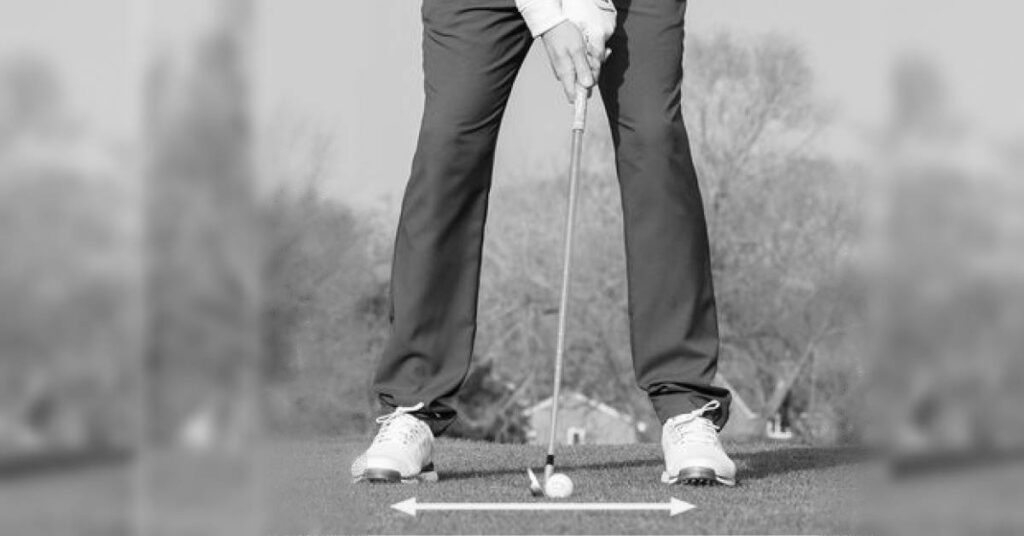
The most obvious component is widening your footing. A wide stance generally means placing your feet at least several inches wider than your shoulder width. Some players may want to go even wider depending on their body type and swing mechanics.
A good starting point is to stand normally and then take a half-step sideways with each foot. This small adjustment alone can help you feel more grounded. Continue experimenting with additional width until you find your optimal wide stance for balance and torque.
Foot Flare
In addition to moving your feet laterally wider, it is also important to flare your feet outward slightly. Your toes should point toward the target at an angle rather than parallel. This outward flare allows your hips to turn fully in the backswing.
Try a 10-30-degree flare to find the right angle for your hip mobility. Setting your feet at too sharp of an outward angle can restrict your ability to shift your weight properly.
Knee Flex
With a wide stance, your knees should have a slight bend rather than being locked straight. The kneecap should be centered over the balls of the feet. Allow your knees to flex naturally as you make your swing rather than forcing an overly bent position.
The knee flex allows your legs to provide stability and power. Keeping knees slightly flexed also enhances balance and athletic readiness through the swing sequence.
Weight Distribution
Distribute your weight evenly between your front and back foot at setup. Your weight should be centered on the balls of your feet with your heels grounded. Do not sway back on your heels.
Maintaining a centered weight will keep you balanced during the backswing and downswing. Adjust your weight forward as you begin the downswing by driving off your back foot.
Try widening your stance incrementally to find the optimal width for your body and flexibility. The ideal position keeps you balanced while allowing for a full shoulder turn. With practice, a wide stance can become second nature and provide consistency across all your clubs.
Benefits of a Wide Golf Stance

Provides Stability
Adopting a wider stance activates more muscles throughout your legs, hips, and core to keep you balanced, as described in this guide to the anatomy of a golf swing. With feet shoulder-width apart or wider, you create a broader base of support. This planted foundation resists swaying and sliding during the swing, helping you maintain your center of gravity.
The improved stability from a wide stance allows your upper body to freely turn against a steady base with balance and control. You will have a solid platform to swing from rather than feeling off-balance.
Generates Power
Widening your stance unlocks your ability to coil more fully on the backswing and explode with force on the downswing. With feet wider apart, your hips can rotate further back and then aggressively clear on the way down. This spiraling force ripples through the sequence to transfer maximum power to the ball.
The leverage created from a wide stance also boosts lag and torque elements that amplify clubhead speed. You can swing out to the ball more aggressively while retaining balance. This kinetic sequence compounds to drive the ball greater distances.
Improves Accuracy
In addition to added distance, a wide stance also enhances accuracy and consistency. The stability keeps your body steadier throughout the swing path, allowing you to make solid contact. Your clubface will return to impact more squarely for straighter shots.
Keeping your head still is also key for accuracy. A wide stance reduces excess upper body movement to maintain your eye focus on the ball. You will be aligned properly all the way through the strike.
Enhances Overall Game
Implementing a wide stance provides benefits to all aspects of your golf game. You can maximize your power and optimize your launch angles to hit great drives. Your iron play will become more precise from added stability. Finesse shots around the green can be shaped with ease.
A wide stance also safeguards your body from injury. The athletic position protects your knees and back from excessive torque. Practicing with proper stance fundamentals will ingrain good biomechanics.
Creating an Effective Wide Stance
Executing a proper wide golf stance begins with your foot positioning. Optimizing your footing is crucial for balance, weight distribution, and allowing full hip turn.
Foot Position
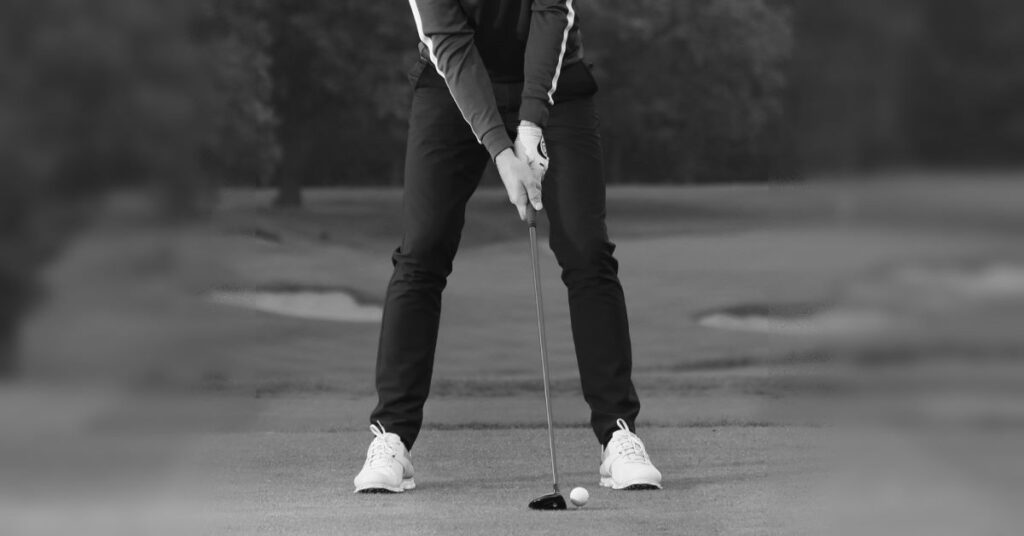
When setting up with a wide stance, start by determining your ideal foot width. Wider than shoulder-width apart is the general guideline. An extra 3-6 inches beyond shoulder width is a good starting point.
Determine Your Stance Width
Here are some tips for finding your optimal wide stance width:
- Start with feet in the middle of the stance then take a half-step outward with each foot
- Adopt a stance where you can coil fully but not so wide that it feels forced
- Try different widths to see what allows you to retain balance in motion
- The stance may vary based on club length – wider for driver, narrower for wedges
- Let your natural hip mobility and swing arc guide the ideal width
Flare Feet Outward Slightly
In addition to widening laterally, also flare your feet outward at about a 15-30 degree angle. This allows your knees and hips to align properly.
Keep Heels Aligned
Point your toes outward but keep your heels lined up with the midline of your torso. Avoid letting heels stray wider than your body.
Proper foot alignment creates a stable foundation for the coil while still allowing weight transfer.
Leg Position
Your knee and leg positioning also affects wide stance execution.
Allow Knees to Flex
With a wide stance, keep your knees relaxed rather than locked straight. Allow 10-15 degrees of flex in your knees to enable an athletic motion.
Weight Evenly Between Feet
Distribute weight evenly between the lead leg and trail leg at setup. Maintain balance centered on the balls of your feet.
Transfer Weight Naturally
As you swing, allow your weight to transfer and shift naturally onto your lead side, without swaying or sliding.
Proper leg and knee mechanics while using a wide stance generate stability and ground force to power your swing.
Experiment with adjusting your foot width, flare angle, and flex until you find your most balanced athletic wide stance. Always be sure to distribute weight evenly at address. Then make adjustments during motion to transfer weight properly.
Back Position
Proper spinal alignment is crucial when using a wide golf stance. Your back posture affects your ability to coil fully and power the swing.
Maintain a Straight But Not Rigid Posture
Set up with your back straight but not overly tense. Find a neutral spine by imagining your back is against a wall with a small gap for the natural arch in your lower back. Avoid rounding or arching too much.
This athletic posture allows your core to naturally stabilize your upper body. It also enables free shoulder turns against resistance to generate torque.
Avoid Arching Lower Back
A common mistake is exaggerating the arch in your lower back due to the wide stance. This overarch can throw off your balance and restrict your backswing.
Keep your pelvis tilted slightly forward to align your spine. Draw your belly button inward to fill the natural gap in your lower back.
Hip Position
Your hip alignment and mobility are also integral when using a wide golf stance. Optimizing hip mechanics is key for power.
Keep Hips Open
At set up, your hips should be aligned parallel to the target line with feet flared outward. Keeping hips open allows clearance for the backswing and weight shift.
Maintain Looseness
Avoid clenching or tightening your glutes and hips at address. Stay loose to enable athletic motion.
Allow Full Rotation
The main benefit of a wide stance is allowing more hip turns. Keep hips mobile and let them rotate fully on the backswing, then aggressively clear on the downswing.
Consciously focus on turning your back hip behind you on the backswing. Clear your hips through impact back toward the target.
Proper spinal posture combined with hip mobility will keep you coiled while retaining balance. Practice rotating your hips fully with each club to fine-tune stance width. Consistently turning through the sequence will help you maximize power.
Common Mistakes to Avoid
While a wide stance can provide many benefits, it must be executed properly. Avoiding common errors will help you get the most out of this technique. Here are some key mistakes to be aware of:
Not Bending Knees Enough
One of the main purposes of a wide stance is to unlock power from the legs. Keeping your knees straight negates this advantage. Locked knees also reduce balance and athletic readiness.
Be sure to allow a slight 10-15 degree bend in your knees at setup. This flex should feel natural, not forced. Properly bent knees help ground your lower body for stability while also enabling you to drive power from your legs.
Tips for Proper Knee Flex
- Soften knees so they are not rigidly straight
- Imagine sitting down in a chair to find the optimal bend
- Keep kneecap over balls of feet with flex
- Adjust the bend to allow athletic motion without overly forcing it
Leaning Back on Heels
When widening your stance, a common instinct is to lean back onto your heels. This disrupts the balance and coils the torso improperly.
Be sure your weight is centered on the balls of your feet at address. Your heels should remain grounded but do not sway onto them.
Maintain Proper Weight Distribution
- Distribute weight evenly between lead and trail foot
- Keep arches activated to avoid heel pressure
- Drive through balls of feet on the downswing
Leaning back can also arch your lower spine. Maintain athletic posture and engage your core.
Keeping Back Overly Straight
Some players rigidly straighten their back attempting to correct spinal alignment. But an overly straight back inhibits mobility.
Instead, find a neutral spine with a micro bend in your knees and a slight forward pelvic tilt. Keep your core engaged but avoid clenching your glutes and hamstrings. This allows freedom of movement.
Improper Hip Rotation
Faulty hip mechanics during the swing is another common error. Limited hip turn forfeits power.
Be sure to keep hips loose at setup. Rotate fully clearing the lead hip back and trail the hip through. Time the sequence with your upper body turn for maximum force.
Practice rotating through the hips independently to develop mobility. Using a wider stance lets you increase hip turn substantially if sequenced properly.
Avoiding these common stance faults will help optimize your balance, posture, and rotational force with a wide stance. While it may feel abnormal initially, practicing proper setup and weight shifts will ingrain good motion habits.
Using a Wide Stance with Different Clubs
While a wide stance is beneficial overall, the ideal width may vary depending on the club you are using. Wider is not always better. Each club has a different desired ball flight and swing characteristics. Stance width should complement those factors.
Here are guidelines for fine-tuning your wide stance for different club types:
Driver Stance
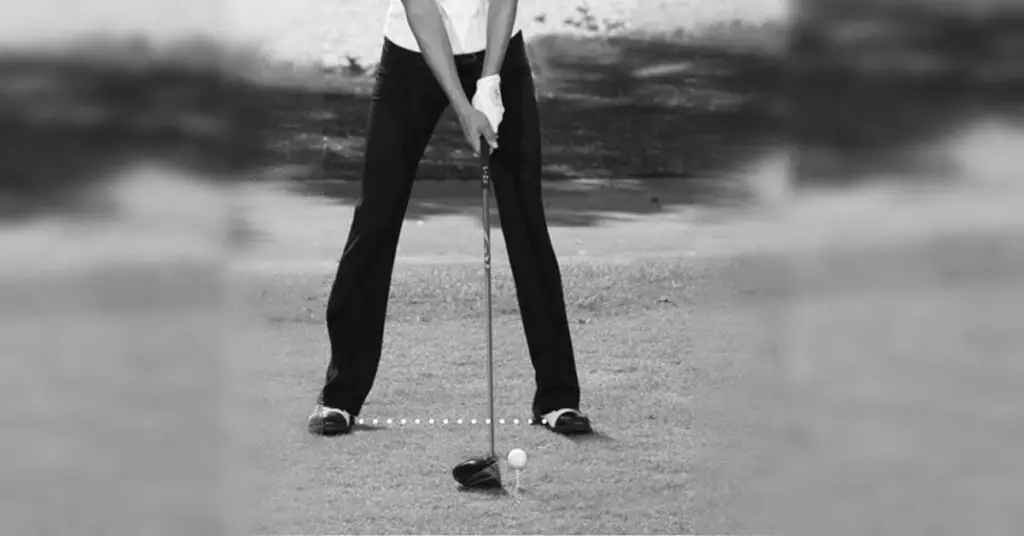
The driver is where a very wide stance works best. When teeing off, distance is more valuable than accuracy. A wider base creates maximum power and launch angle.
Use an Extra-Wide Stance
For the driver, start with a stance at the wide end of your optimal range. An extra 3-6 inches wider than the shoulders often works well. This ultra-wide base allows for:
- Greater weight shift and hip rotation for explosive force
- Higher launch angle due to added loft when turning against resistance
- Delayed release for more clubhead speed through impact
Prioritize Power Over Control
With the driver, power is paramount. Use the widest stance you can while still retaining balance and mobility. The penalty for errant drives is low on most holes, so favor power.
Allow Exaggerated hip and shoulder turn
Take advantage of the wide base to make an aggressive shoulder and hip turn away from the ball, then violently clear on the downswing. This will boost speed substantially.
Iron Stance
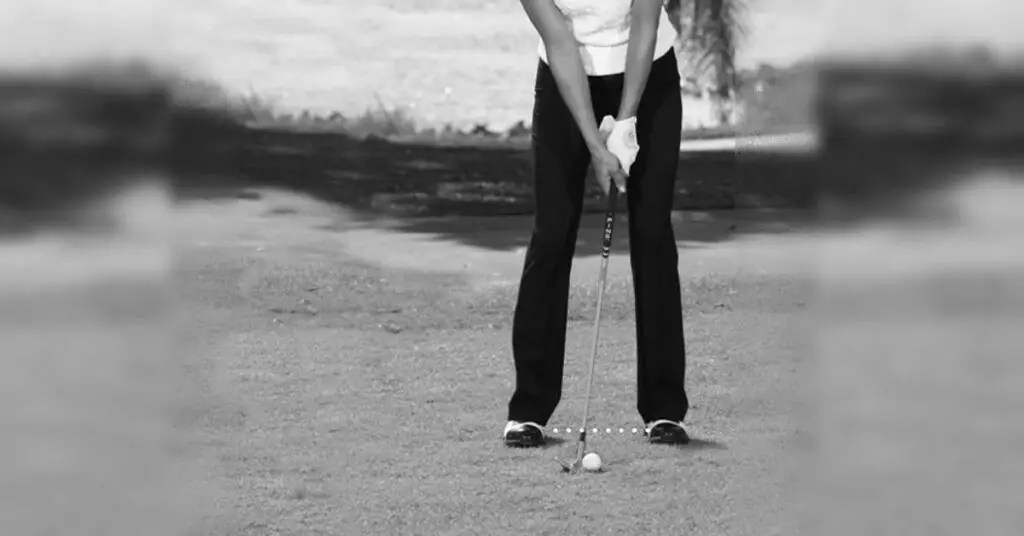
For mid and long irons, reduce your stance width slightly from the driver setup. These clubs require a blend of distance and control.
Moderate Stance Width
Start with feet just outside shoulder width for mid-irons like the 6-7. For longer irons like the 4-5, go closer to shoulder width. This moderate width promotes balance.
Allow Full Hip Turn
Still, turn your hips fully on the backswing, but reduce the violent clearing motion through impact. Irons require more precise contact.
Prioritize Consistent Ball Striking
With irons, consistent solid contact is more important than maximizing power. Use the stance width that keeps you most balanced through the strike.
Wedge Stance
As you get to the higher lofted wedges, begin gradually narrowing your stance width. Finesse becomes increasingly important closer to the green.
Stance Slightly Narrower Than Irons
For pitching and gap wedges, start with a stance slightly narrower than your normal iron width. For lob wedges, go closer to shoulder width to enhance control.
Reduce Hip Turn
Make a slightly shorter shoulder and hip turn on the backswing since power is not the priority. Focus on consistent contact and ball position.
Allow Varied Weight Shift
Vary weight distribution and feel free to make subtle adjustments during the swing to optimize wedge precision.
Putter Stance
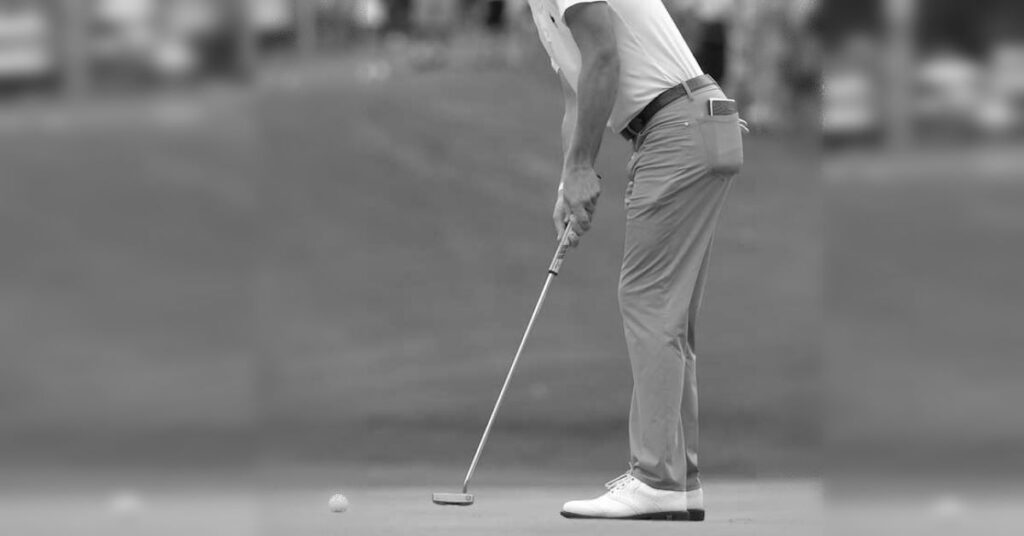
For putting, a wide stance can also provide advantages depending on the length of the putt.
Wider for Short Putts
On short putts within 10 feet, a wider stance up to shoulder width provides stability to consistently stroke straight putts. This reduces yips and jitters.
Narrower for Long Putts
On lag putts outside 10 feet, shift to a narrower stance, closer to feet together. This improves feel, touch, and ability to smoothly accelerate through impact.
Experiment with making small adjustments in your wide stance width based on the club. Optimizing for each club’s specific needs will enhance your overall game.
For a detailed guide on optimizing your stance for each specific club, check out our in-depth article on proper golf stance for each club.
Tips for Practicing with a Wide Stance
Implementing a wide golf stance takes practice to master. Here are some tips for ingraining this technique:
Start with Driver and Irons
When first practicing a wide stance, begin with the clubs that benefit most – driver and irons. Hit range balls with a driver using an extra wide base, focusing on balance and hip turn. Then dial back stance width slightly with mid-irons.
Spending time ingraining proper mechanics with these clubs will prepare you to optimize the stance for wedges and putters.
Progress to Wedges and Putter
After becoming comfortable with a wide stance for driver swings and iron strikes, begin incrementally narrowing the stance for wedges and putter.
Make small adjustments downward club by club until you find the ideal width for finesse based on your tempo and flexibility.
Practice on Different Surfaces
Take advantage of varied practice conditions to improve wide stance balance. Hit off-level driving range mats, contoured fairway lies, sidehill slopes, and buried shots.
Varying surfaces will challenge your stability and ingrain proper weight transfer adjustments.
Use Training Aids
Training aids like impact bags and balance boards are useful for developing a wide stance. An impact bag teaches core activation and weight shift. Use a balance board to feel how stance width affects equilibrium.
These tools isolate important elements like posture, balance, and hip turn for focused practice.
Be patient when implementing a wide stance, allowing time to find proper mechanics for each club based on ball flight needs. With deliberate practice across different lies and surfaces, a wide base will become second nature.
Conclusion
Implementing a wide golf stance provides many concrete benefits that can elevate your overall game. By simply widening your footing beyond shoulder width, you activate more muscles to enhance power, stability, consistency, and injury prevention.
With a properly wide base, you can unlock greater hip rotation for increased driving distance. The solid foundation also keeps you balanced throughout the swing, leading to more solid ball striking and accuracy. A wide stance aligns your body mechanically for optimal performance.
However, a wide stance must be carefully executed for each club and swing type. The ideal width and exact mechanics will vary based on factors like flexibility, swing arc, and desired ball flight. It takes practice to find your optimal wide stance for power versus finesse shots.
The keys are positioning your feet laterally wider, flaring both feet outward, maintaining spine angle, and allowing full clearance of the hips. Start by practicing with your driver and mid-irons using an incrementally wider base. Then dial in the reduced width for wedges and putter.
If done correctly, adopting a wide stance can provide noticeable improvements across all aspects of your game. More power and control leads to increased driving distance, pinpoint iron accuracy, deft wedge play, and confident putting. A wide base truly establishes a solid foundation upon which to build your best possible golf swing.
While it may seem counterintuitive at first, learning the nuances of a wide stance through dedicated practice can transform your shot-making abilities. Follow the tips outlined above and this simple setup tweak will become an invaluable weapon in your golfing arsenal for years to come.


Greetings! Very helpful advice in this particular article! Its the little changes that produce the largest changes. Thanks a lot for sharing!